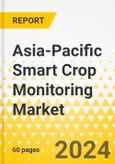10% Free customization
The Asia-Pacific smart crop monitoring market (excluding China) was valued at $432.9 million in 2023, and it is expected to grow with a CAGR of 18.56% during the forecast period 2023-2028 to reach $1,014.4 million by 2028. The growth of the crop monitoring market is anticipated to stem from the rising need for maximizing crop yields and resource utilization efficiency in agriculture. Furthermore, advancements in AI, machine learning, and remote sensing technologies are poised to accelerate the growth of crop monitoring even further. This report comes with 10% free customization, enabling you to add data that meets your specific business needs.
Market Introduction
The Asia-Pacific (APAC) smart crop monitoring market is witnessing significant growth attributed to the region's evolving agricultural landscape and the increasing adoption of advanced technologies. With the APAC region being a key contributor to global agricultural output, there's a growing imperative to enhance productivity, optimize resource use, and ensure food security. Smart crop monitoring solutions offer farmers real-time insights into crop health, soil conditions, and environmental factors, enabling them to make data-driven decisions and implement precision agriculture practices. Moreover, factors such as population growth, changing consumer preferences, and climate variability are driving the demand for smart crop monitoring technologies in APAC. Countries such as China, India, Japan, and Australia are at the forefront of adopting these solutions, supported by government initiatives, technological advancements, and a growing awareness of the benefits of smart agriculture. As the APAC region continues to modernize its farming practices, the smart crop monitoring market is poised for significant growth and innovation.Market Segmentation:
Segmentation 1: by Application
- Disease and Pest Detection
- Nutrient Management
- Weed Management
- Crop Insurance
- Others
Segmentation 2: by Product
- Sensor Technology
- Drones
- Robots
- Handheld Devices
- Software and Mobile Applications
Segmentation 3: by Country
- Japan
- India
- Australia and New Zealand
- Rest-of-Asia-Pacific
How can this report add value to an organization?
Product/Innovation Strategy: In the realm of smart crop monitoring, technological advancements are transforming agricultural landscapes. Smart crop monitoring solutions utilize diverse technologies such as IoT sensors, drones, and data analytics. These tools offer precise insights into crop health, optimizing irrigation, pest management, and harvest times. Innovations such as satellite imaging and remote sensing provide a holistic view of fields, empowering farmers to make informed decisions. The market encompasses a range of solutions, from real-time monitoring platforms to AI-driven predictive analysis, enabling farmers to enhance productivity and reduce resource wastage significantly.Growth/Marketing Strategy: The smart crop monitoring market has witnessed remarkable growth strategies by key players. Business expansions, collaborations, and partnerships have been pivotal. Companies are venturing into multiple markets, forging alliances, and engaging in research collaborations to enhance their technological prowess. Collaborative efforts between tech companies and agricultural experts are driving the development of cutting-edge monitoring tools. Additionally, strategic joint ventures are fostering the integration of diverse expertise, amplifying the market presence of these solutions. This collaborative approach is instrumental in developing comprehensive, user-friendly, and efficient smart crop monitoring systems.
Competitive Strategy: In the competitive landscape of smart crop monitoring, manufacturers are diversifying their product portfolios to cover various crops and farming practices. Market segments include soil analysis tools, disease detection systems, and climate analysis solutions. Competitive benchmarking illuminates the strengths of market players, emphasizing their unique offerings and regional strengths. Partnerships with research institutions and agricultural organizations are driving innovation.
This product will be delivered within 3-5 business days.
Table of Contents
Scope of the StudyExecutive Summary
1 Markets
2 Region
3 Markets - Competitive Benchmarking & Company Profiles
4 Research Methodology
List of Figures
List of Tables
Companies Mentioned
- KUBOTA Corporation
- DJI
Table Information
| Report Attribute | Details |
|---|---|
| No. of Pages | 60 |
| Published | May 2024 |
| Forecast Period | 2023 - 2028 |
| Estimated Market Value ( USD | $ 432.9 Million |
| Forecasted Market Value ( USD | $ 1014.4 Million |
| Compound Annual Growth Rate | 18.5% |
| Regions Covered | Asia Pacific |
| No. of Companies Mentioned | 2 |









